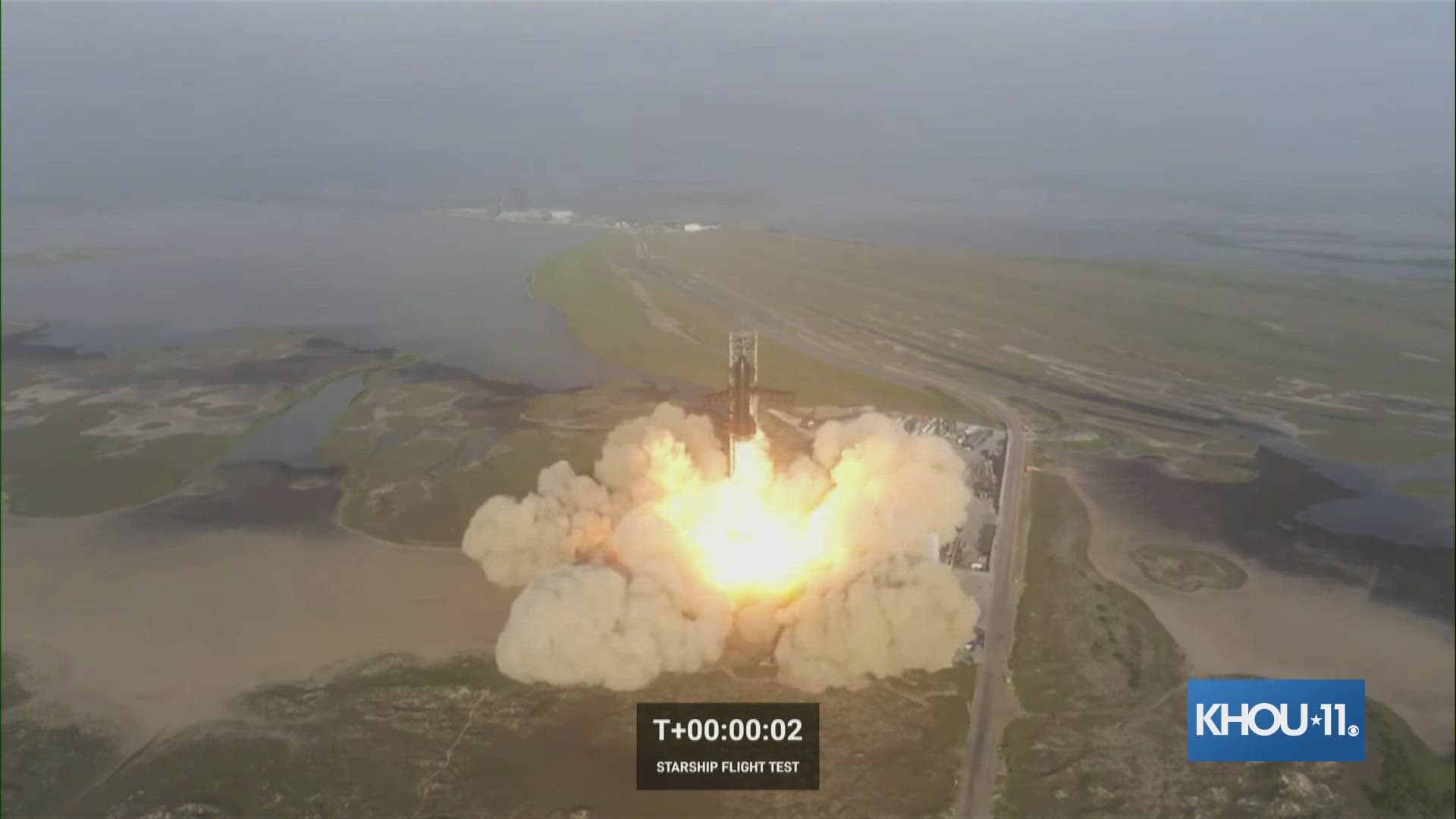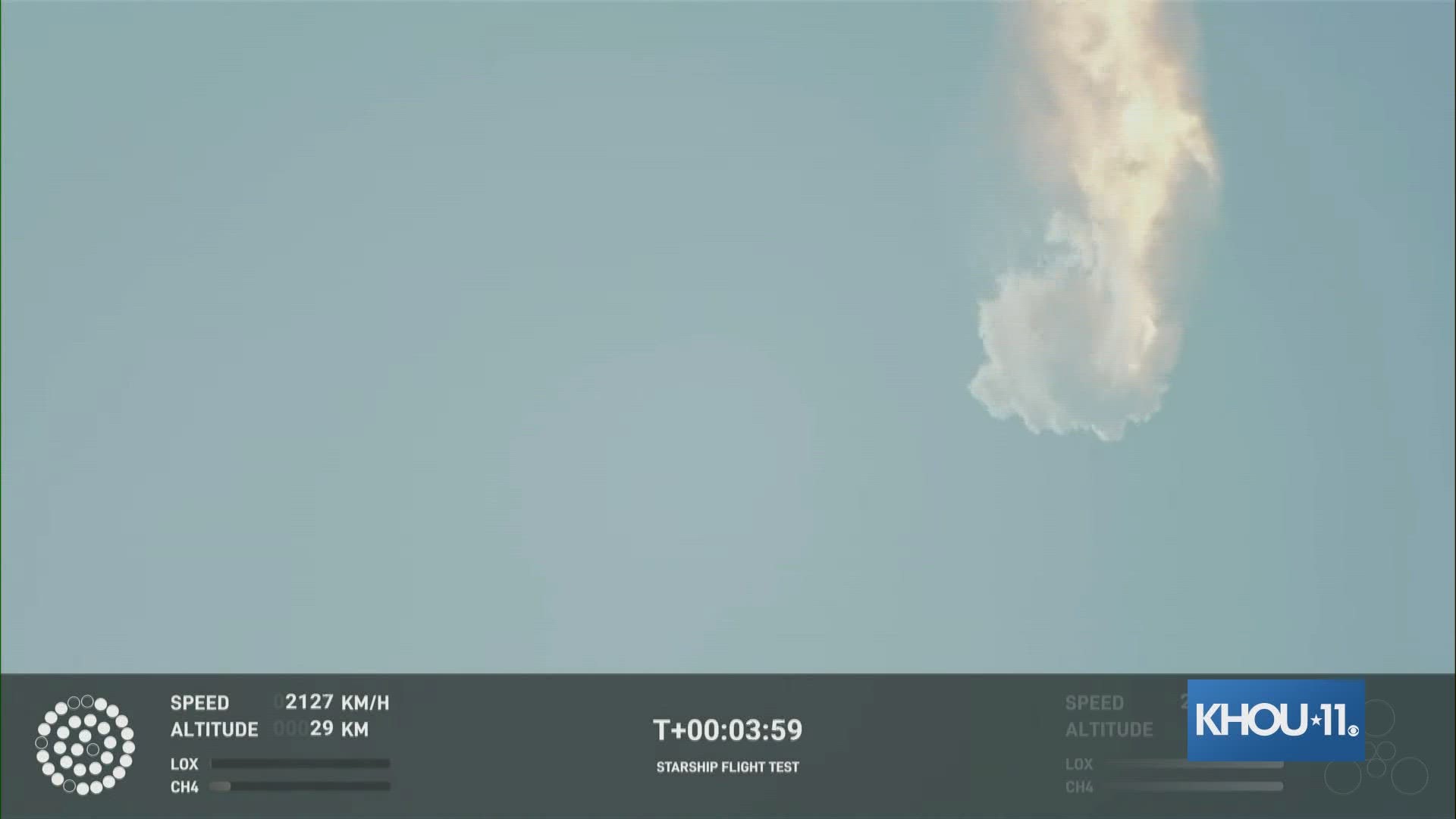SOUTH PADRE ISLAND, Texas — SpaceX’s giant new rocket exploded minutes after blasting off on its first test flight Thursday and crashed into the Gulf of Mexico.
Elon Musk’s company was aiming to send the nearly 400-foot Starship rocket on a round-the-world trip from the southern tip of Texas, near the Mexican border. It carried no people or satellites.
Images showed several of the 33 main engines were not firing as the rocket climbed from the launch pad, reaching as high as 24 miles. There was no immediate word from SpaceX on how many engines failed to ignite or shut down prematurely.
The booster was supposed to peel away from the spacecraft three minutes after liftoff, but that didn't happen. The rocket with the spacecraft still attached began to tumble and then exploded, plummeting into the gulf.
Once flying free, the spacecraft was meant to lap around the world, ending with a crash-landing in the Pacific near Hawaii.
Instead of a best-case scenario 1 1/2-hour flight, it lasted four minutes.
Throngs of spectators watched from South Padre Island, several miles away from the Boca Chica Beach launch site, which was off-limits. As it lifted off, the crowd screamed: “Go, baby, go!”
Musk, in a tweet, called it “an exciting test launch of Starship! Learned a lot for next test launch in a few months.”
In the weeks leading up to the flight, Musk gave 50-50 odds that the spacecraft would reach orbit.
“You never know exactly what’s going to happen," said SpaceX livestream commentator and engineer John Insprucker. “But as we promised, excitement is guaranteed and Starship gave us a rather spectacular end.”
The company plans to use Starship to send people and cargo to the moon and, eventually, Mars. NASA has reserved a Starship for its next moonwalking team, and rich tourists are already booking lunar flybys.
At 394 feet and nearly 17 million pounds of thrust, Starship easily surpasses NASA’s moon rockets — past, present and future. The stainless steel rocket is designed to be fully reusable with fast turnaround, dramatically lowering costs, similar to what SpaceX’s smaller Falcon rockets have done soaring from Cape Canaveral, Florida. Nothing was to be saved from the test flight.
The futuristic spacecraft flew several miles into the air during testing a few years ago, landing successfully only once. But this was to be the inaugural launch of the first-stage booster with 33 methane-fueled engines.
SpaceX has more boosters and spacecraft lined up for more test flights. Musk wants to fire them off in quick succession, so he can start using Starships to launch satellites into low-Earth orbit and then put people on board.
It was the second launch attempt. Monday’s try was scrapped by a frozen booster valve.
Jason and Lisa Flores came from Corpus Christi to watch the launch with their daughter and noticed something was amiss.
Lisa Flores said she cried seeing the launch, and then realized “It’s not working out the way it was supposed to.”
Elizabeth Trujillo, 13, wearing a “Star Wars” shirt and carrying toy binoculars, skipped school to see the launch from the beach with her mother and other relatives. The crowd cheered when Starship cleared the launch pad.
Despite the failed attempt, “it was worth it,” said Jessica Trujillo, Elizabeth’s mother. “Just hearing and seeing the view, the excitement of the crowd, it was priceless.”
“Practice makes perfect. They just got to practice some more,” she added.
“I've been waiting for this, really, for years,” said Bob Drwal, a retired engineer who drove down from Chicago with his wife, Donna.
Here’s the rundown on Starship’s debut:
SUPERSIZE ROCKET
The stainless steel Starship has 33 main engines and 16.7 million pounds of thrust. All but two of the methane-fueled, first-stage engines ignited during a launch pad test in January — good enough to reach orbit, Musk noted. Given its muscle, Starship could lift as much as 250 tons and accommodate 100 people on a trip to Mars. The six-engine spacecraft accounts for 164 feet (50 meters) of its height. Musk anticipates using Starship to launch satellites into low-Earth orbit, including his own Starlinks for internet service, before strapping anyone in. Starship easily eclipses NASA’s moon rockets — the Saturn V from the bygone Apollo era and the Space Launch System from the Artemis program that logged its first lunar trip late last year. It also outflanks the former Soviet Union’s N1 moon rocket, which never made it past a minute into flight, exploding with no one aboard.
GAME PLAN
The test flight will last 1 1/2 hours, and fall short of a full orbit of Earth. If Starship reaches the three-minute mark after launch, the booster will be commanded to separate and fall into the Gulf of Mexico. The spacecraft would continue eastward, passing over the Atlantic, Indian and Pacific oceans before ditching near Hawaii. Starship is designed to be fully reusable but nothing will be saved from the test flight. Harvard astrophysicist and spacecraft tracker Jonathan McDowell will be more excited whenever Starship actually lands and returns intact from orbit. It will be "a profound development in spaceflight if and when Starship is debugged and operational,” he said.
LAUNCH PAD
Starship will take off from a remote site on the southernmost tip of Texas near Boca Chica Beach. It's just below South Padre Island, and about 20 miles from Brownsville. Down the road from the launch pad is the complex where SpaceX has been developing and building Starship prototypes for the past several years. The complex, called Starbase, has more than 1,800 employees, who live in Brownsville or elsewhere in the Rio Grande Valley. The Texas launch pad is equipped with giant robotic arms — called chopsticks — to eventually grab a returning booster as it lands. SpaceX is retooling one of its two Florida launch pads to accommodate Starships down the road. Florida is where SpaceX's Falcon rockets blast off with crew, space station cargo and satellites for NASA and other customers.
CUSTOMERS
With Starship, the California-based SpaceX is focusing on the moon for now, with a $3 billion NASA contract to land astronauts on the lunar surface as early as 2025, using the upper stage spacecraft. It will be the first moon landing by astronauts in more than 50 years. The moonwalkers will leave Earth via NASA’s Orion capsule and Space Launch System rocket, and then transfer to Starship in lunar orbit for the descent to the surface, and then back to Orion. To reach the moon and beyond, Starship will first need to refuel in low-Earth orbit. SpaceX envisions an orbiting depot with window-less Starships as tankers. But Starship isn't just for NASA. A private crew will be the first to fly Starship, orbiting Earth. Two private flights to the moon would follow — no landings, just flyarounds.
OTHER PLAYERS
There are other new rockets on the horizon. Jeff Bezos’ Blue Origin is readying the New Glenn rocket for its orbital debut from Cape Canaveral, Florida, in the next year or so. Named after the first American to orbit the world, John Glenn, the rocket towers over the company’s current New Shepard rocket, named for Mercury astronaut Alan Shepard’s 1961 suborbital hop. NASA will use New Glenn to send a pair of spacecraft to Mars in 2024. United Launch Alliance expects its new Vulcan rocket to make its inaugural launch later this year, hoisting a private lunar lander to the moon at NASA’s behest. Europe’s Arianespace is close to launching its new, upgraded Ariane 6 rocket from French Guiana in South America. And NASA’s Space Launch System moon rocket that will carry astronauts will morph into ever bigger versions.


